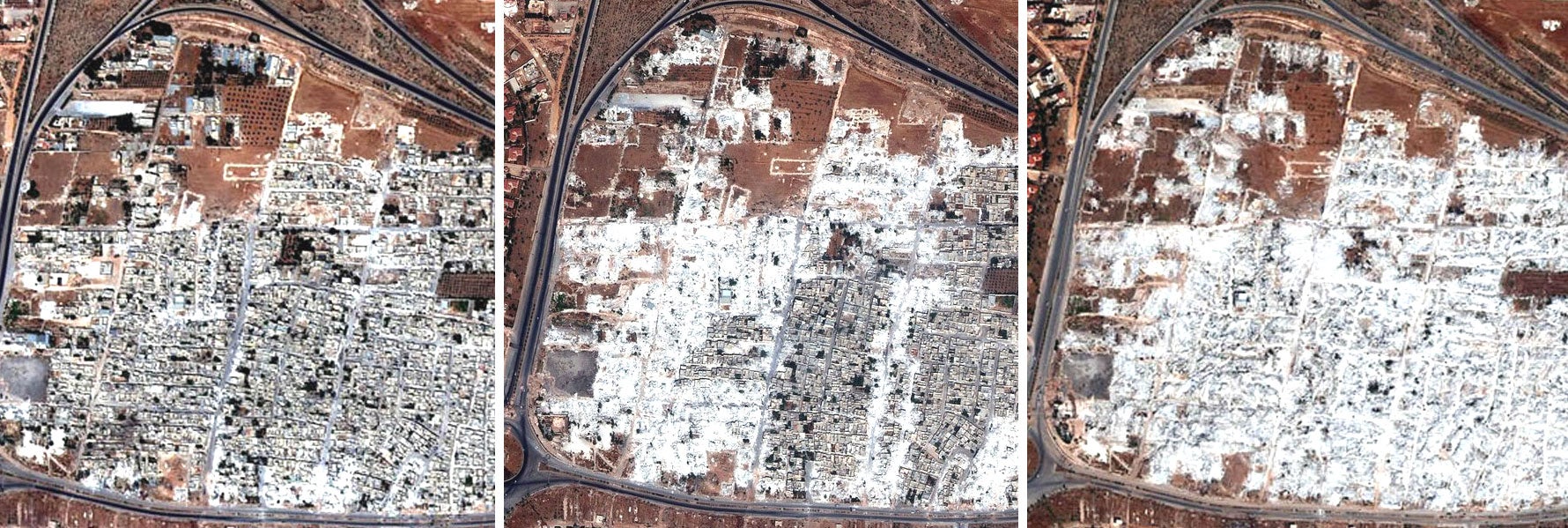‘We want to destroy’: Entire neighbourhoods demolished by Syrian army
Shocking satellite images show devastation in districts that back opposition to President Assad

Your support helps us to tell the story
From reproductive rights to climate change to Big Tech, The Independent is on the ground when the story is developing. Whether it's investigating the financials of Elon Musk's pro-Trump PAC or producing our latest documentary, 'The A Word', which shines a light on the American women fighting for reproductive rights, we know how important it is to parse out the facts from the messaging.
At such a critical moment in US history, we need reporters on the ground. Your donation allows us to keep sending journalists to speak to both sides of the story.
The Independent is trusted by Americans across the entire political spectrum. And unlike many other quality news outlets, we choose not to lock Americans out of our reporting and analysis with paywalls. We believe quality journalism should be available to everyone, paid for by those who can afford it.
Your support makes all the difference.The main road entering Damascus from the north runs for several miles through a sea-scape of ruins. On each side of the road there are smashed buildings with collapsed concrete roofs and heaps of rubble, without a person in sight, in places that used to provide housing and workplaces for tens of thousands of people.
I drove up and down this road two years ago and districts such as Harasta, Qaboun and Jobar looked battered by fighting but were essentially intact. There were big car showrooms whose owners had built rough concrete walls in front of them in a vain attempt to protect their large, glass windows. Today these places look as if they have been carpet-bombed, with scarcely a habitable house visible from the road.
In fact, these areas in north Damascus as well as others in the south and west of the capital have been systematically pounded into ruins by Syrian army artillery, or bulldozed into extinction. The reason is that they were seen as opposition strongholds and were strategically located on access routes for rebels, or close to important roads. A further motive is collective punishment by the government which wants to show that any opposition will be met with inevitable and merciless retribution.
The government itself claims that it carried out the demolitions because, in the middle of a savage civil war, it suddenly decided to demolish houses that did not have full planning permission.
The destruction of these districts is recounted in a report by Human Rights Watch called Razed to the Ground: Syria’s Unlawful Neighbourhood Demolitions in 2012-13. It shows satellite pictures of six districts, two in Hama, four in Damascus, before and after destruction, and has interviews with eyewitnesses. The rights group estimates the total built-up area destroyed at 360 acres, equivalent to 200 football pitches, and said many of the buildings were apartment blocks of up to eight storeys.
Masha al-Arb’een, a poor district in north Hama, had been used by rebels to get in and out of the city and was close to the Hama-Aleppo highway. It was demolished between 27 September and 13 October 2012. One woman says: “When the bulldozers approached.... My husband was begging [the soldiers] to spare our house, but they shouted: ‘We want to destroy, we want to destroy’.”
Another Hama neighbourhood, called Wadi al-Jouz, was bulldozed in April-May 2013. Afterwards the army toured a nearby district announcing, according to a resident, that it would be destroyed like “Wadi al-Jouz and Masha al-Arb`een should a single bullet be fired from here”.
It does not seem to have made any difference that in many places residents could do nothing about rebel fighters firing from their buildings.
Qaboun in Damascus had seen fierce fighting between rebels and government forces in July 2012 and was destroyed over a lengthy period. A restaurant owner called Walid says: “I saw the bulldozer demolishing my shop. The shop was opened by my grandfather many years ago... all of my family’s hard work was destroyed in one second.”
Walid told HRW that the demolition took place over 50 days: “The army demolished 1,250 shops and 650 homes. 1,800 families had to evacuate. There were two or three families in every house. The Syrian army gave the shop-owners 24 hours to empty their shops. Homeowners were given only three hours to pack their stuff and leave. It was not enough time. People barely took anything with them.”
Demolition by bulldozer was not the only means of destruction. Anywhere seized by the rebels was cordoned off by government forces, bombarded by artillery and effectively depopulated.
Siege of Yarmouk: Blocked aid
The siege of 18,000 Palestinians in Yarmouk in south Damascus is easing with the distribution of over 1,000 food parcels by UNWRA.
Previous efforts to distribute aid had been aborted or had only limited success because of a lack of Syrian government co-operation. People in the opposition-controlled part of Yarmouk are reported to have been living on weeds and the odd stray donkey or other animals.
The agency said after a full day 1,026 food parcels were distributed. One food parcel will feed a family of up to eight for about 10 days. It said it had received reports of signs of malnutrition.
Patrick Cockburn
Join our commenting forum
Join thought-provoking conversations, follow other Independent readers and see their replies
Comments